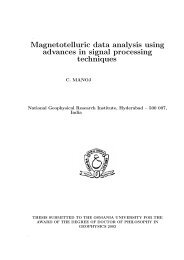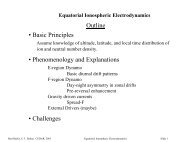Scaling statistical analysis of magnetic and gravity data
Scaling statistical analysis of magnetic and gravity data
Scaling statistical analysis of magnetic and gravity data
Create successful ePaper yourself
Turn your PDF publications into a flip-book with our unique Google optimized e-Paper software.
Figure 3: Radially averaged log power spectrum <strong>of</strong> the<br />
KTB aero<strong>magnetic</strong> survey. The solid line indicates the<br />
model power spectrum for 19.23, = <strong>and</strong><br />
= 2.07 (after Maus & Dimri, 1995).<br />
the intensity <strong>of</strong> density or susceptibility variations,<br />
reflects the anisotropy <strong>of</strong> the <strong>magnetic</strong> field (for the <strong>gravity</strong><br />
field is the scaling exponent <strong>of</strong> the field<br />
<strong>and</strong> is the distance between the observation plane <strong>and</strong><br />
the top <strong>of</strong> the model half-space. Fig. 3 shows the fit <strong>of</strong><br />
the model power spectrum defined by eq. (2) to the power<br />
spectrum <strong>of</strong> a real aero<strong>magnetic</strong> <strong>data</strong> set. In this case the<br />
radially averaged power spectrum was used. However,<br />
radial averaging leads to a loss <strong>of</strong> information <strong>and</strong> future<br />
methods are likely to use the original 2D power spectrum,<br />
instead.<br />
Applications<br />
The model power spectrum defined by eq. (2) is governed<br />
by three parameters, <strong>and</strong> which can be derived by<br />
<strong>statistical</strong> <strong>analysis</strong> <strong>of</strong> a survey <strong>and</strong> can subsequently be<br />
displayed as maps. All three parameters describe different<br />
aspects <strong>of</strong> the <strong>gravity</strong> or <strong>magnetic</strong> field.<br />
The depth to the top <strong>of</strong> the sources is particularly interesting<br />
in the study <strong>of</strong> sedimentary basins, where it may<br />
reflect the depth to the crystalline basement or the depth<br />
to certain intra-basin geological structures.<br />
The Intensity quantifies the amplitude <strong>of</strong> susceptibility<br />
<strong>and</strong> density variations while taking into account the distance<br />
<strong>of</strong> the sources from the observation plane. Hence,<br />
the parameter can be high even for a weak field anomaly,<br />
if the depth to the source anomaly is high at the same<br />
<strong>Scaling</strong> <strong>statistical</strong> <strong>analysis</strong><br />
1420<br />
Figure 4: A window is moved over the survey area. For<br />
every position <strong>of</strong> the window an inversion is carried out<br />
using the <strong>data</strong> within the window. Here, the resulting<br />
depths to source are displayed as a pr<strong>of</strong>ile.<br />
time. A further attractive feature <strong>of</strong> the parameter is<br />
that it can be derived from <strong>magnetic</strong> <strong>data</strong> without a reduction<br />
to the pole.<br />
The third parameter, the scaling exponent reflects <strong>statistical</strong><br />
properties <strong>of</strong> the source distributions. As discussed<br />
below, it may be useful in separating different<br />
types <strong>of</strong> geology, such as volcanic from metamorphic, or<br />
Recent from Precambrian.<br />
The optimum values for these parameters are obtained<br />
by inversion. An appropriately sized ‘window is moved<br />
over the <strong>data</strong> set (Fig. 4), <strong>and</strong> an inversion <strong>of</strong> the <strong>data</strong><br />
within the window is carried out to derive the best values<br />
for <strong>and</strong> at every position <strong>of</strong> the window. The<br />
values for subsequent inversions (= window positions) can<br />
then be plotted as pr<strong>of</strong>iles (Fig. 4 & 5), or as maps <strong>of</strong><br />
the particular parameter. However, due to a trade-<strong>of</strong>f<br />
between the scaling exponent <strong>and</strong> the depth to source<br />
only one <strong>of</strong> these two parameters can be resolved at a<br />
time.<br />
To obtain the depth to source, a constant scaling exponent<br />
has shown to be a reasonable assumption in areas<br />
without major changes in the geology <strong>of</strong> the basement.<br />
Pilkington <strong>and</strong> Todoeschuck 7 used a value <strong>of</strong> = 3, while<br />
7 = 2 was used in another case study 8 (Fig. 4 & 5). Using<br />
a lower scaling exponent leads to greater depth estimates<br />
<strong>and</strong> vice-versa. Thus, the method can be calibrated by<br />
choosing the scaling exponent in such a way that the inversion<br />
yields the correct depth to source for a window<br />
with known basement depth.<br />
If, on the other h<strong>and</strong>, the area has outcropping sources






